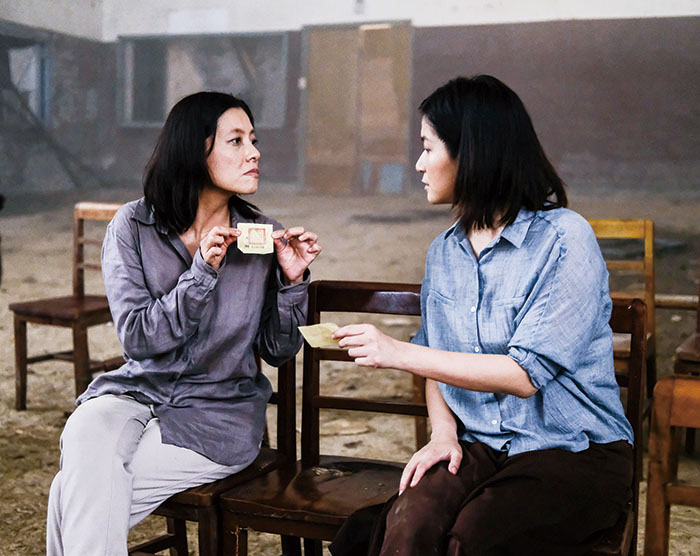Presenting Director Mr. Cheng Li-ming's Phantom Cinema/作一場老戲院的夢─《空一格,戲院》
Presenting Director Mr. Cheng Li-ming's Phantom Cinema
◎English translation: Hou Ya-ting
◎Photo courtesy of Cheng Li-ming
As well as directing Phantom Cinema, Mr. Cheng Li-ming also plays the role of a mysterious man in his film. His character sometimes squats by the projection window, gazing at the empty theater. He waves a flashlight, captivating those watching with light and shadow. He guides audience members to their seats, recalling how Taiwanese people used to watch movies in theaters rather than at home. He picks up abandoned rolls of film, touching these reminders of the past. The character he plays wanders through the cinema like a phantom. He encounters two girls, convoluting this elusive, dreamy story.
Mr. Cheng Li-ming, a native of Changhua County who now lives in Taipei, graduated from Shih Hsin University's Department of Radio, Television & Film. He has worked at the Taiwan Film Institute and the Executive Committee of the Taipei Golden Horse Film Festival. These experiences broadened his horizons, and he evolved into an astute film critic. He is now an independent director. In 2014, his documentary Looking for Siraya, about lowland indigenous people in Kaohsiung's Neimen District, won him a prize at the Golden Harvest Awards & Short Film Festival, a prominent platform for talented young filmmakers in Taiwan.
 For Mr. Cheng, cinema is a way of presenting multiple perspectives on life, and it embodies both his interests and nostalgic memories of his hometown in Changhua County. During his childhood, Mr. Cheng frequented Yingong Movie Theater, which has since become a clothing store. However, he chose to film Phantom Cinema in the First Movie Theater in Kaohsiung's Meinong District.
For Mr. Cheng, cinema is a way of presenting multiple perspectives on life, and it embodies both his interests and nostalgic memories of his hometown in Changhua County. During his childhood, Mr. Cheng frequented Yingong Movie Theater, which has since become a clothing store. However, he chose to film Phantom Cinema in the First Movie Theater in Kaohsiung's Meinong District.
In 1970, some 826 movie theaters were operating in Taiwan. However, because of the rise of TV and video, together with people moving from smaller towns to big cities, a great many theaters closed down. Meinong's First Movie Theater shut its doors for good in 1991. Changhua's Yigong Theater closed down in 1997. Islandwide, the number of surviving movie theaters fell to around 200.
Some may ask why Mr. Cheng filmed Phantom Cinema in Meinong. After winning an award in Taiwan's Short Film Base category at the 2016 Kaohsiung Film Festival for Phantom Cinema, he points out that many Taipei-based movie-makers are willing to submit works to Kaohsiung Film Festival. The festival has been praised for attracting highly creative and original works without restricting the type of subject. Mr. Cheng is not new to the Kaohsiung Film Festival, as Looking for Siraya won in the Short Film Base category in the 2013 edition of the festival. Even though parts of Looking for Siraya were shot in Tainan, the festival still embraced the film. Since then, Mr. Cheng has enjoyed participating in Kaohsiung Film Festival's Taiwan's Short Film Base project.
Mr. Cheng chose to use Meinong's First Movie Theater as a location for Phantom Cinema because the building is largely intact. "It's a shame the First Movie Theater doesn't have an ideal projection window," he says, "so some of the indoors scenes were filmed at the Sanduo Movie Theater in Sanmin District in Kaohsiung." Mr. Cheng describes Phantom Cinema as more than a documentary, and rather like a collective dreamland.
To fully apply experimental film techniques, Phantom Cinema weaves a sophisticated plot through images, dance, history, and screening clips from other films. Among those screened is the 1956 classic Love Amongst War, the first Taiwanese movie to use Holo (the local language also known as Taiwanese or Minnanhua) and a landmark in the development of Taiwanese cinema. He included Hakka elements to reflect Meinong being a bastion of Hakka culture. Phantom Cinema also features an outdoor screening of Cinema Paradiso, an acclaimed Italian film.
Phantom Cinema further builds a connection with Meinong by showing a few final scenes of vintage photographs, some showing Mr. Jhong Hao-dong. Jhong, who relocated to Meinong at the age of 18, was a prominent victim of the White Terror (a period of political repression in Taiwan after World War II). Jhong's older brother was the noted Meinong-based writer Jhong Li-he (also known as Chung Li-ho). Jhong Hao-dong's life has inspired many people, and the novel Sapporo Carriage Song tells his story.
Mr. Cheng says he did not know Jhong Hao-dong was related to Jhong Li-he, and believes many do not know his life story. Mr. Cheng himself learned about Jhong Hao-dong by watching A City of Sadness and Good Men, Good Women, two movies by renowned director Hou Hsiao-hsien. Mr. Cheng takes this opportunity to salute Jhong Hao-dong, saying he was a significant historical figure. Through his lens, Mr. Cheng narrates stories in various forms and perspectives, giving audiences alluring plots to decode.
作一場老戲院的夢─《空一格,戲院》
◎文/謝佳錦
◎圖片提供/鄭立明
導演鄭立明在《空一格,戲院》裡,飾演神秘男子。有時蹲在放映窗望著空蕩戲院;有時揮舞手電筒以光影魅惑觀者;有時撿起廢棄膠卷,觸摸消逝的記憶。角色如徘徊戲院的遊魂,與兩名女子相遇,編織一場迷離奇美、朝現實外擴的夢。
鄭立明是彰化人,現居台北。世新電影科畢業後,任職國家電影資料館、金馬影展執委會,曾是視野卓絕的影評人,現為前衛大膽的獨立導演。以高雄內門平埔族為題材的《尋找木柵女》,曾獲金穗獎最佳實驗片。電影對鄭立明來說,是興趣與工作,也是鄉愁。小時候常跑的彰化銀宮戲院現在已經變成服飾店,而非《空一格,戲院》拍攝場地美濃第一戲院。
1970年全台戲院826家,受人口外移、電視及錄影帶衝擊,1991年第一戲院停業,1997年輪到銀宮戲院,全台約剩200多家。戲院凋零是全台現象,為何到高雄拍?鄭立明認為高雄徵件創作導向且題材開放,《尋找木柵女》風格獨具,雖然部分在台南拍,仍獲青睞,讓他對高雄電影館的「高雄拍」計畫有好感。挑選第一戲院是因其保有獨立外觀,可惜放映窗不適合取景,有些內景選在三民區中都戲院。鄭導演表示:「這不是單純的紀錄片,比較實驗,像是一個地下記憶、集體夢境。」
《空一格,戲院》片中放映1956年的《薛平貴與王寶釧》,鄭立明說:「這是第一部台語片,20幾年前我在電影資料館研究台語片時,以為佚失了。現在不但找到,還發現是客語配音。原來當年去客家庄放片要這樣做,類似外國電影用字幕或配音。」藉此把台灣電影史和他的個人觀影歷程、美濃客家背景串連起來。
此外,今年四月第一戲院戶外放映《新天堂樂園》,鄭立明不只留下影像紀錄,也巧妙融入實驗手法。末段出現的老照片,是田野調查的意外收穫。照片上的人是白色恐怖受難者鍾浩東,美濃文學家鍾理和的弟弟,小說《幌馬車之歌》的主角。鄭立明說:「我這一代是從《悲情城市》、《好男好女》等侯孝賢電影去認識這個人物,但我完全不知他是鍾理和的弟弟,也不知是美濃人。很多人可能也不知道。」
電影是投向銀幕的光束,不只是一道射向人們心中老戲院回憶的光,導演也以博學與巧手,朝歷史與現實的幽暗角落折射。